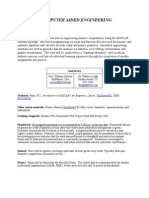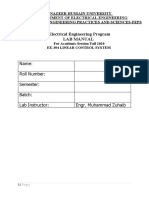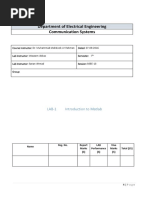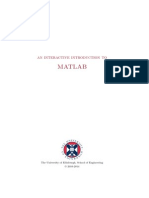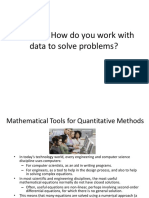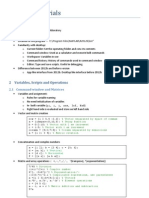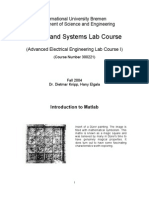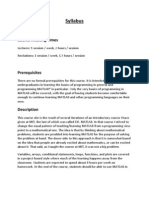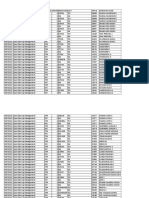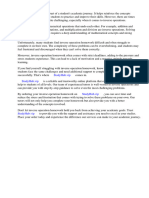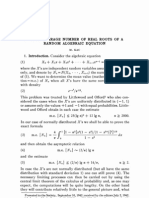0 ratings0% found this document useful (0 votes)
62 viewsWeek Wise Lab Plan Chapters To Be Covered: (2, 3, 4, 5, 8, 9, 10, 12, (13-14 Optional) )
This 1-credit required course introduces students to MATLAB and its applications in engineering. The course consists of lectures, classroom exercises, and computer-based exercises to provide hands-on experience using MATLAB. Topics include fundamental MATLAB operations, control structures, solving equations symbolically, graphical data representation, differentiation, and integration. Students will learn to use MATLAB for tasks like data analysis, visualization, and numeric computation. The course aims to give students fluency in MATLAB and its use for engineering problems. Assessment includes class attendance, rubrics, assignments, team projects, and a final exam.
Uploaded by
Akbar S. UetCopyright
© © All Rights Reserved
Available Formats
Download as DOCX, PDF, TXT or read online on Scribd
0 ratings0% found this document useful (0 votes)
62 viewsWeek Wise Lab Plan Chapters To Be Covered: (2, 3, 4, 5, 8, 9, 10, 12, (13-14 Optional) )
This 1-credit required course introduces students to MATLAB and its applications in engineering. The course consists of lectures, classroom exercises, and computer-based exercises to provide hands-on experience using MATLAB. Topics include fundamental MATLAB operations, control structures, solving equations symbolically, graphical data representation, differentiation, and integration. Students will learn to use MATLAB for tasks like data analysis, visualization, and numeric computation. The course aims to give students fluency in MATLAB and its use for engineering problems. Assessment includes class attendance, rubrics, assignments, team projects, and a final exam.
Uploaded by
Akbar S. UetCopyright
© © All Rights Reserved
Available Formats
Download as DOCX, PDF, TXT or read online on Scribd
You are on page 1/ 3
COURSE NUMBER & COURSE TITLE: ME 300 MATLAB and its application in Engineering
INSTRUCTOR: H.M. Shahid Credits: 1 Language of instruction: English
Akbar
REQUIRED COURSE OR ELECTIVE COURSE: TERMS OFFERED: Fall semester
Required Course
COURSE STRUCTURE/SCHEDULE: PRE-REQUISITES:
Normal lecture Advanced Mathematics
Computer based exercise Linear Algebra
TEXTBOOK/READING LIST
Text book
1. MATLAB for Engineers 3rd/4th Ed., by Holly Moore
2. MATLAB : an introduction with applications, Amos Gilat Hoboken, N.J. ; Chichester : Wiley 4th ed., International
student ed.. c2011
Reading list
1. Introduction to MATLAB for engineers William J (William John) Palm, 1944-New York : McGraw-Hill 3rd ed.. c201
2. An engineer's guide to MATLAB Edward B Magrab Upper Saddle River, NJ : Prentice Hall c2006
3. A guide to MATLAB for beginners and experienced users Brian R Hunt, Cambridge, UK ; New York : Cambridge
University Press 2001
LAB DESCRIPTION:
Matlab is one of the most widely used high-level computing languages; it provides users a friendly and interactive
environment for algorithm development, data visualisation, data analysis, and numeric computation. With its exten
libraries of mathematical and graphical routines, Matlab is widely used in areas such as signal and image processing
communications, control design, test and measurement, financial modelling and analysis, and computational biolog
This course provides a progressively gentle introduction to Matlab. It is designed to give students fluency in Matlab
including fundamentals of Matlab, programming, solving mathematic equations with Matlab, data visualisation etc.
Besides normal lecturing, this course also provides student computer based exercise, which ensures student unders
and master the key knowledge of Matlab.
COURSE LEARNING OUTCOMES (CLOs)
After successful completion of this Lab session, students should be able to:
1. Become familiar with fundamental operations in Matlab for data conversion and tabular
representation,
2. applying control structures for advanced engineering appliucation and solving algebraic equations
using symbolic math techniques.
3. Applying MATLAB forgraphical data representation and differentiation and integration techniques.
Week Wise Lab Plan
Chapters to be covered: [2, 3, 4, 5, 8, 9, 10, 12, (13-14 optional)] Example
Week 1. Introduction to Matlab, Using variables, Matrices in MATLAB, Number display 2.1,2.2,2
techniques , exercis
Week 2. Built-in functions, math funtions, rounding functions, trigonometric functions, problem
miscellaneous functions, defining matrices, colon operator 3.1,3.2,4
Week 3. 2D plotting, multiple plotting, subplots, polar plots, logarithmic plots, Bar and Pie charts, xy- 4.2,4.3,5
graphs with two axis,
,5.3,5.4,
Week 4. 3D plots, line, surface, mesh and contour plots, control structures, if-end, if-else-end, if-elseif-
else-end, switch-case, for and while loops
8.1, 8.2,
9.5,10.7
12.2,12.
,12.5
Week 5.Solution of equations, Symbolic math, symbolic algebra, symbolic functions, symbolic plotting, differentiat
and integration
TEACHING STYLE
1. Normal lecture
2. Classroom exercise and discussion
3. Computer based exercise
STUDENT’S LEARNING STYLE
1. Students presentation during some of session break
2. Course projects to be done during the term. Teamwork is highly encouraged in and after class discussion and team
projects
3. Assignment
4. A final exam
GRADING FORMAT AND POLICY
1 Class attendance 10%
2 Rubrics 20%
PREPARED BY: HM Shahid REVISION DATE: Aug. 20, 2017
You might also like
- Engineering Computation An Introduction Using MATLAB and Excel PDF100% (2)Engineering Computation An Introduction Using MATLAB and Excel PDF337 pages
- Ch01 - Introduction To MATLAB+Ch02 - MATLAB Basics (Part 1)No ratings yetCh01 - Introduction To MATLAB+Ch02 - MATLAB Basics (Part 1)66 pages
- Engr 104: Computer Aided Engineering Course SyllabusNo ratings yetEngr 104: Computer Aided Engineering Course Syllabus4 pages
- Mathematical Programming For Engineers: Course Objectives Course OutcomesNo ratings yetMathematical Programming For Engineers: Course Objectives Course Outcomes2 pages
- Buy ebook (eBook PDF) MATLAB for Engineers Global Edition 5th Edition cheap price100% (2)Buy ebook (eBook PDF) MATLAB for Engineers Global Edition 5th Edition cheap price41 pages
- Department of Electrical Engineering Communication Systems: LAB-1 Introduction To MatlabNo ratings yetDepartment of Electrical Engineering Communication Systems: LAB-1 Introduction To Matlab5 pages
- EEE604 Electrical Engineering Modeling UD PDFNo ratings yetEEE604 Electrical Engineering Modeling UD PDF4 pages
- Introduction To Numerical Methods and Matlab Programming For EngineersNo ratings yetIntroduction To Numerical Methods and Matlab Programming For Engineers182 pages
- SS LAB MANUAL 2024 - Updated (Reduced Syllabus For Endsem Exam)No ratings yetSS LAB MANUAL 2024 - Updated (Reduced Syllabus For Endsem Exam)60 pages
- Lab Work File: 5 Semester ECE (2017 Batch)No ratings yetLab Work File: 5 Semester ECE (2017 Batch)24 pages
- MATLAB: How Do You Work With Data To Solve Problems?No ratings yetMATLAB: How Do You Work With Data To Solve Problems?75 pages
- Course Title: Course Code: Credit Hours: Program: Semester: Course InstructorNo ratings yetCourse Title: Course Code: Credit Hours: Program: Semester: Course Instructor178 pages
- Foundations of Engineering With MATLAB 7: Eric S. CarlsonNo ratings yetFoundations of Engineering With MATLAB 7: Eric S. Carlson14 pages
- Introduction To Numerical Methods and Matlab Programming For Engineers PDFNo ratings yetIntroduction To Numerical Methods and Matlab Programming For Engineers PDF182 pages
- IBIO 2240 PROGRAMACIÓN CIENTÍFICA-201510-Prof. J Son PDFNo ratings yetIBIO 2240 PROGRAMACIÓN CIENTÍFICA-201510-Prof. J Son PDF3 pages
- Syllabus - Introduction To MATLAB ProgrammingNo ratings yetSyllabus - Introduction To MATLAB Programming4 pages
- Courses For Academic Year: Department of Mechanical Engineering, Imperial College of Science, Technology and MedicineNo ratings yetCourses For Academic Year: Department of Mechanical Engineering, Imperial College of Science, Technology and Medicine2 pages
- Finite Field Fun: A lightweight introduction to finite fields and their applications for engineers, computer scientists, and othersFrom EverandFinite Field Fun: A lightweight introduction to finite fields and their applications for engineers, computer scientists, and othersNo ratings yet
- Advanced Techniques in Dynamic Programming: A Comprehensive Guide for Java DevelopersFrom EverandAdvanced Techniques in Dynamic Programming: A Comprehensive Guide for Java DevelopersNo ratings yet
- LU 1b Fundamentals of Algebra II - StudentNo ratings yetLU 1b Fundamentals of Algebra II - Student38 pages
- Fall 2021 - 22 Course Allocation ReportNo ratings yetFall 2021 - 22 Course Allocation Report117 pages
- Applications of Derivatives To Business and Economics100% (1)Applications of Derivatives To Business and Economics13 pages
- VR17 - First Year Syllabus PO-CO Mapping Updated - EEENo ratings yetVR17 - First Year Syllabus PO-CO Mapping Updated - EEE37 pages
- Nonlinear Equations and Systems of Equations (Level 1) Answer KeyNo ratings yetNonlinear Equations and Systems of Equations (Level 1) Answer Key13 pages
- On The Average Number of Real Roots of A Random Algebric Equation by M. KacNo ratings yetOn The Average Number of Real Roots of A Random Algebric Equation by M. Kac7 pages
- Geometrically Nonlinear Analysis of Plane Truss and Frames PDF50% (2)Geometrically Nonlinear Analysis of Plane Truss and Frames PDF385 pages
- Mock AIME I 2015 Solutions Packet: X 20 13 3x 2 3 3x A BNo ratings yetMock AIME I 2015 Solutions Packet: X 20 13 3x 2 3 3x A B8 pages
- Modul SBP SPM 2014 Perfect Score Add Math PDFNo ratings yetModul SBP SPM 2014 Perfect Score Add Math PDF83 pages
- A Knowledge Based Approach For Elastomer Cure Kinetic Parameters EstimationNo ratings yetA Knowledge Based Approach For Elastomer Cure Kinetic Parameters Estimation6 pages
- Simplified Solution For Elliptical BodiesNo ratings yetSimplified Solution For Elliptical Bodies3 pages








